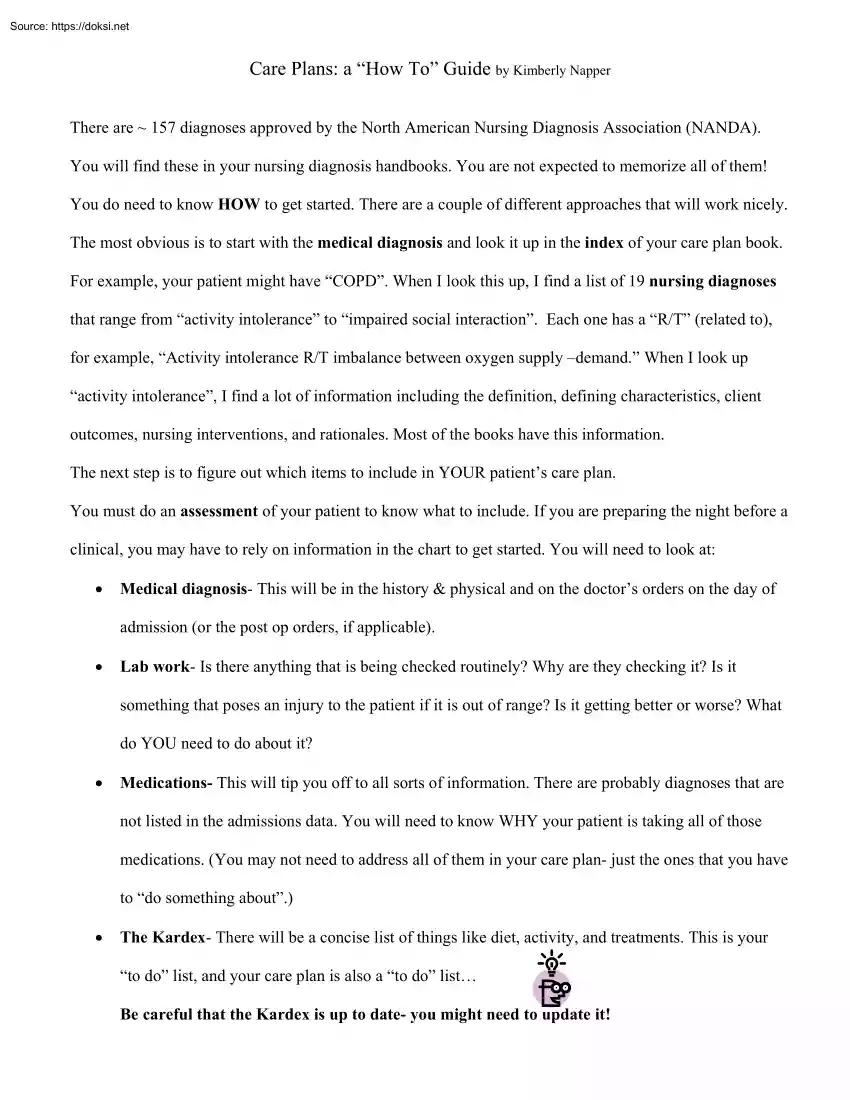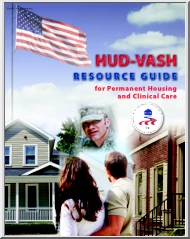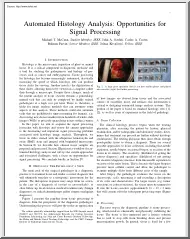Please log in to read this in our online viewer!

Please log in to read this in our online viewer!
No comments yet. You can be the first!
What did others read after this?
Content extract
Care Plans: a “How To” Guide by Kimberly Napper There are ~ 157 diagnoses approved by the North American Nursing Diagnosis Association (NANDA). You will find these in your nursing diagnosis handbooks. You are not expected to memorize all of them! You do need to know HOW to get started. There are a couple of different approaches that will work nicely The most obvious is to start with the medical diagnosis and look it up in the index of your care plan book. For example, your patient might have “COPD”. When I look this up, I find a list of 19 nursing diagnoses that range from “activity intolerance” to “impaired social interaction”. Each one has a “R/T” (related to), for example, “Activity intolerance R/T imbalance between oxygen supply –demand.” When I look up “activity intolerance”, I find a lot of information including the definition, defining characteristics, client outcomes, nursing interventions, and rationales. Most of the books have this information
The next step is to figure out which items to include in YOUR patient’s care plan. You must do an assessment of your patient to know what to include. If you are preparing the night before a clinical, you may have to rely on information in the chart to get started. You will need to look at: • Medical diagnosis- This will be in the history & physical and on the doctor’s orders on the day of admission (or the post op orders, if applicable). • Lab work- Is there anything that is being checked routinely? Why are they checking it? Is it something that poses an injury to the patient if it is out of range? Is it getting better or worse? What do YOU need to do about it? • Medications- This will tip you off to all sorts of information. There are probably diagnoses that are not listed in the admissions data. You will need to know WHY your patient is taking all of those medications. (You may not need to address all of them in your care plan- just the ones that you have to “do
something about”.) • The Kardex- There will be a concise list of things like diet, activity, and treatments. This is your “to do” list, and your care plan is also a “to do” list Be careful that the Kardex is up to date- you might need to update it! The “to do” list is another way to get started with your care plan. You may know what you need to do for your patient, but you are not really sure how to put it into a care plan form. For example, if you have a debilitated client who needs you to turn her every 2 hours and feed her, think about WHY you need to do this for her. (Because she can’t do it herself? Does she have a “self-care deficit”?) (Because she can’t move herself? Could it be “Immobility” R/T what?? Paralysis from a stroke? Weakness from an electrolyte imbalance? Something else?) You will have to look up information in the chart to explain what is going on & why you need to do certain things for your patient. Sometimes you will find a
diagnosis & not know what you should do about it Sometimes you will know what you need to do but may be unsure of the diagnosis that makes these actions necessary. Either way, your assessment of your patient along with your research into the medical aspects of the diagnosis should tie it all together. This will get easier with practice The nursing interventions are the specific actions that you will take to help your patient recover. Examples of interventions: Turn every 2 hours, Monitor blood pressure every 4 hours, Assist to bedside commode when needed (at least once this shift), Monitor & record client’s ability to tolerate activity: note pulse rate, B/P, respiratory effort before and after activity. (Notice that they are specific, like instructions) The “rationale” is why you would do those interventions. Your care plan book lists rationales with the interventions. Make sure the things you choose are appropriate for THIS patient It’s not “one size fits all”
Every patient will be different and will need a “customized” care plan. The “evaluation” is “How did your plan of care & your interventions work?” Tell what happened with your patient. For example, if you have a patient with a “self care deficit” and your goal /intervention was to have the patient assist with his bath as much as possible, tell how that worked out! “Patient brushed his own teeth but required total care with bath and stated, ‘I am too exhausted to wash my own face.’” Or, “Patient ambulated to sink with standby assistance only. Managed bath without help, but respirations became rapid at 40 breaths/ min.” See how the pieces all fit together? Your care plan is a recipe for managing your patient. You should be able to hand it to someone, and they will know what to do for your patient and why
The next step is to figure out which items to include in YOUR patient’s care plan. You must do an assessment of your patient to know what to include. If you are preparing the night before a clinical, you may have to rely on information in the chart to get started. You will need to look at: • Medical diagnosis- This will be in the history & physical and on the doctor’s orders on the day of admission (or the post op orders, if applicable). • Lab work- Is there anything that is being checked routinely? Why are they checking it? Is it something that poses an injury to the patient if it is out of range? Is it getting better or worse? What do YOU need to do about it? • Medications- This will tip you off to all sorts of information. There are probably diagnoses that are not listed in the admissions data. You will need to know WHY your patient is taking all of those medications. (You may not need to address all of them in your care plan- just the ones that you have to “do
something about”.) • The Kardex- There will be a concise list of things like diet, activity, and treatments. This is your “to do” list, and your care plan is also a “to do” list Be careful that the Kardex is up to date- you might need to update it! The “to do” list is another way to get started with your care plan. You may know what you need to do for your patient, but you are not really sure how to put it into a care plan form. For example, if you have a debilitated client who needs you to turn her every 2 hours and feed her, think about WHY you need to do this for her. (Because she can’t do it herself? Does she have a “self-care deficit”?) (Because she can’t move herself? Could it be “Immobility” R/T what?? Paralysis from a stroke? Weakness from an electrolyte imbalance? Something else?) You will have to look up information in the chart to explain what is going on & why you need to do certain things for your patient. Sometimes you will find a
diagnosis & not know what you should do about it Sometimes you will know what you need to do but may be unsure of the diagnosis that makes these actions necessary. Either way, your assessment of your patient along with your research into the medical aspects of the diagnosis should tie it all together. This will get easier with practice The nursing interventions are the specific actions that you will take to help your patient recover. Examples of interventions: Turn every 2 hours, Monitor blood pressure every 4 hours, Assist to bedside commode when needed (at least once this shift), Monitor & record client’s ability to tolerate activity: note pulse rate, B/P, respiratory effort before and after activity. (Notice that they are specific, like instructions) The “rationale” is why you would do those interventions. Your care plan book lists rationales with the interventions. Make sure the things you choose are appropriate for THIS patient It’s not “one size fits all”
Every patient will be different and will need a “customized” care plan. The “evaluation” is “How did your plan of care & your interventions work?” Tell what happened with your patient. For example, if you have a patient with a “self care deficit” and your goal /intervention was to have the patient assist with his bath as much as possible, tell how that worked out! “Patient brushed his own teeth but required total care with bath and stated, ‘I am too exhausted to wash my own face.’” Or, “Patient ambulated to sink with standby assistance only. Managed bath without help, but respirations became rapid at 40 breaths/ min.” See how the pieces all fit together? Your care plan is a recipe for managing your patient. You should be able to hand it to someone, and they will know what to do for your patient and why




 When reading, most of us just let a story wash over us, getting lost in the world of the book rather than paying attention to the individual elements of the plot or writing. However, in English class, our teachers ask us to look at the mechanics of the writing.
When reading, most of us just let a story wash over us, getting lost in the world of the book rather than paying attention to the individual elements of the plot or writing. However, in English class, our teachers ask us to look at the mechanics of the writing.